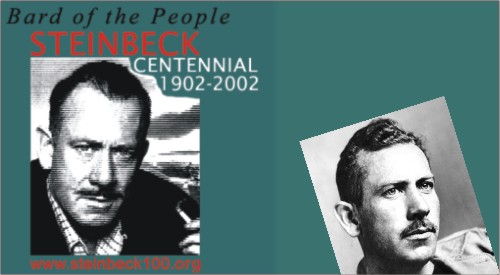| Author Profile
John Steinbeck

John Steinbeck attended Stanford University intermittently between 1920 and 1926 but did not earn a degree. He worked as a manual labourer while writing, and his experiences lent authenticity to his depictions of the lives of the workers in his stories. He spent much of his life in California's Monterey County.
His first three novelsCup of Gold (1929), The Pastures of Heaven (1932), and To a God Unknown (1933)were unsuccessful, but he achieved popularity with Tortilla Flat (1935; film, 1942), an affectionately told story of Mexican-Americans. In Dubious Battle (1936) is a classic account of a strike by farm workers. The novella Of Mice And Men (1937; films, 1939, 1999) is a tragic story about the strange, complex bond between two migrant laborers. Another notable achievement of this period was The Red Pony (1937; film, 1949).
The Grapes Of Wrath (1939, Pulitzer Prize; film, 1940), the story of the migration of a dispossessed family from the Oklahoma Dust Bowl to California and their subsequent exploitation by a ruthless system of agricultural economics, earned him international fame. It was the last of his naturalistic novels of the 1930s with proletarian themes, works which, with their rich symbolic structures, effectively convey the mythopoetic and symbolic qualities of his characters.
During World War II Steinbeck wrote several effective pieces of propagandistic fiction, among them The Moon Is Down (1942; film, 1943), a novel of Norwegians under the Nazis, and also served as a war correspondent. His immediate postwar workCannery Row (1945; film, 1982), The Pearl (1947; film, 1948), The Wayward Bus
Works by John Steinbeck
Tortilla Flat (1935; film, 1942)
In Dubious Battle (1936)
Of Mice And Men (1937; films, 1939, 1999)
The Red Pony (1937; film, 1949)
The Grapes Of Wrath (1939, Pulitzer Prize; film, 1940)
The Moon Is Down (1942; film, 1943)
Cannery Row (1945; film, 1982)
The Pearl (1947; film, 1948)
The Wayward Bus (1947; film, 1957)
Burning Bright (1950)
East of Eden (1952; film, 1955)
The Winter of Our Discontent (1961)
Travels with Charley (1962)
(1947; film, 1957)contained the familiar elements of his social criticism but were more relaxed and sentimental in tone. His later writings were slighter works of entertainment and journalism, including the highly popular Travels with Charley (1962), interspersed with three attempts to reassert his stature as a major novelist: Burning Bright (1950), East of Eden (1952; film, 1955), and The Winter of Our Discontent (1961). In critical opinion, none equaled his earlier achievement. Outstanding among his original screenplays were Forgotten Village (1941) and Viva Zapata! (1952). He received the Nobel Prize for Literature in 1962.
Copyright
(R) thedailystar.net 2007 |
